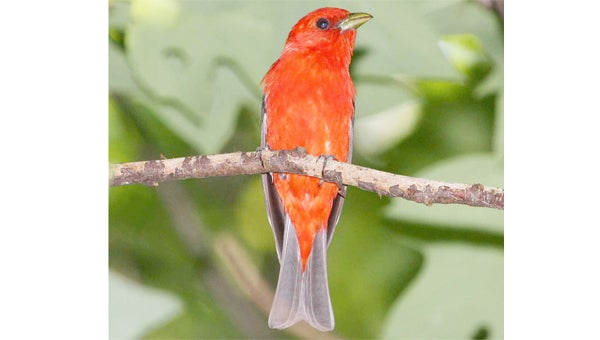Summer and Scarlet Tanagers
Published 4:23 pm Monday, September 10, 2012
Those other “red birds” here
Most of us are familiar with the “red-bird” – the local name for the Northern Cardinal, but cardinals are not the only red birds here in western North Carolina. We have two additional species that may be confused with the far more widespread and abundant cardinal. These are the summer and scarlet tanagers. Both of these species are neotropical migrants that spend the winter in Central or South America and the breeding season here with us in the Carolinas; both arriving in our area around the second week of April.
Aside from being predominantly red in coloration, there is not a great deal of similarity between the male cardinal and the two tanagers. We should all be familiar with most, if not all, of the cardinal’s field marks. The males are medium sized songbirds with uniformly red plumage, a large pink-orange bill adapted for cracking seeds, a black face and, of course, a crest that can be raised or lowered – depending on the bird’s mood. They are found in a range of habitats from lowland to the highlands; from coastal scrub to mountain thickets – a true sign of a very adaptable species.
Both of our tanagers are a little smaller than the cardinal and do not show any crest at all. Let’s start with the more common of the two species, especially here in the mountains of Western North Carolina. This is the scarlet tanager – truly a bird of the South American rainforests where it joins dozens of resident tanager species to spend the northern winter. It is a fairly common bird in the rich deciduous forest that covers the mountains and can be easy to see in the low to mid elevations along the Blue Ridge Escarpment. The males are blood-red in coloration, set off with jet black wings and tail. The bill is yellowish and not anywhere near as massive as that of the Cardinal. The female scarlet tanager mirrors her mate’s plumage, except that her colors are a muted green instead of flame red. What is interesting is that after the breeding season, the male molts his beautiful red feathers and becomes green like the female. He, however, retains his dark wings and tail.
The summer tanager is an uncommon migrant through western North Carolina, although it is a fairly common species in the foothills and coastal plain. This species prefers mixed deciduous and pine woodlands and can also occur in pine plantations. The summer is quite different to the scarlet with the male having a larger and paler bill, deep rose-red body feathers and no dark wings or tail. The female is again unicolored and can range from yellow-green to golden brown – quite different to the female of the scarlet tanager. Also, once the male acquires his breeding colors, he does not molt them into a winter plumage.


